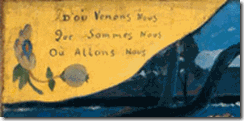Paul Gauguin famously inscribed three big questions in the top corner of his painting that goes under their name. They give a useful framework for grouping the issues that arise as we do theology in the context of science today:
- Where do we come from?
Creation in cosmology and theology, order beauty and intelligibility, laws and miracles, noetic reality and active intelligence, divine agency, intuition and hunch - What are we?
Neuroscience and AI, free will and materialism, complexity emergence consciousness, dignity and morality - Where are we going?
Evolutionary theory, teleology purpose and providence, suffering and waste, altruism, convergence, end of world/life and eschatology resurrection life after death
Around these sit inevitably the two great classic issues
- Ontology – what do we mean by real and what is real (if reality ‘is’)?
- Epistemology – how do we apprehend and know what is real (if we do)?
So what approach should we take? I think there are broadly three stances we can take:
- Defend: apologetics, to some extent seeing science as a threat
(a) facing towards science – addressing its perceived challenges
(b) facing towards the church – addressing its questions & concerns - Develop: affirming value of science but offering a wider frame
(a) epistemological – exploring knowledge/belief/faith in and beyond science
(b) ethical – exploring how science should be approached and used - Disagree: being precise about differences and how to act in response to them
(a) actual disagreements, which are clear points of choice/division
(b) potential disagreements, where it is agreed there is no conclusive evidence
- I would like to see (1) focus on (b) rather more, to resource clergy & congregations in their own thinking before they engage in argument with other
- I would like to see (1) controversy move towards (2) conversation where it can
- And where it can’t it would be good to set an example of “good disagreement” (3)
A major interest for me is not so much looking for new “solutions” to these issues as engaging in improved (for me) communication about them, seeking to undermine the popular narrative of conflict and choice between religion and science, and to resource a more creative conversation in which both religion/faith and science are engaged (with an assumption that to some extent we are all scientists and all have beliefs/faiths).
Such communication and conversation will happen at many levels
- Academic research and encounter (eg in the Cambridge Theology Faculty)
- Public engagement /education programmes (eg via the Faraday Institute)
- Leadership formation (eg the new C of E Bishops’ project)
- Informal conversation between practitioners (eg my own sabbatical)
- Books for a general readership (of the making of which there is no end)
- Broadcast media (which could be better …)
- Social media (which has yet to be really used here)
- Sermons and church discussions/courses (more is needed)
What sort of result can be hoped for from e.g. a 15 minute sermon vs a 15 second Instagram video, a 40 minute TV show vs a 40 character tweet? How can well-funded and high-quality work at the “top” of this ladder feed through to the rungs “below”? I’m hoping to find out.

